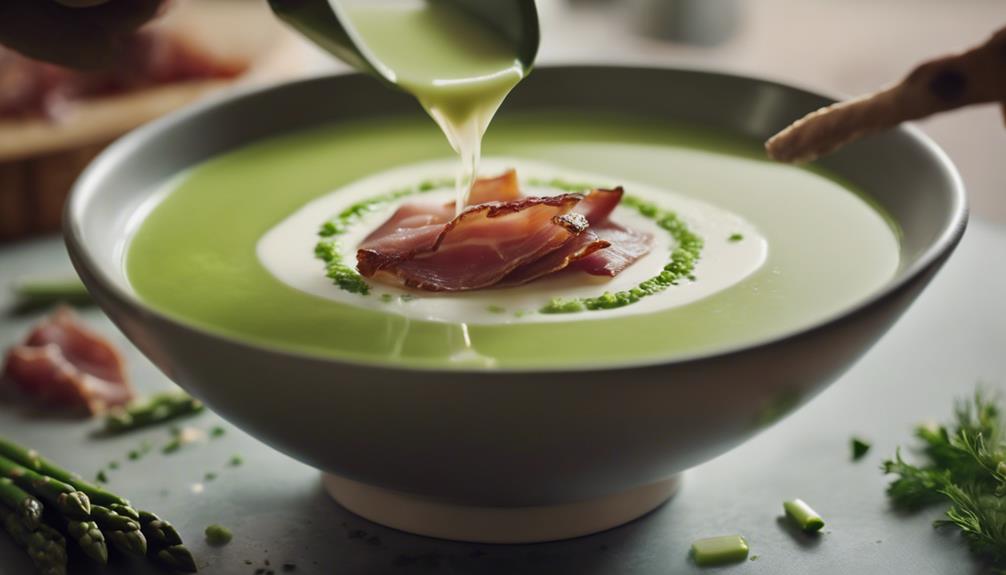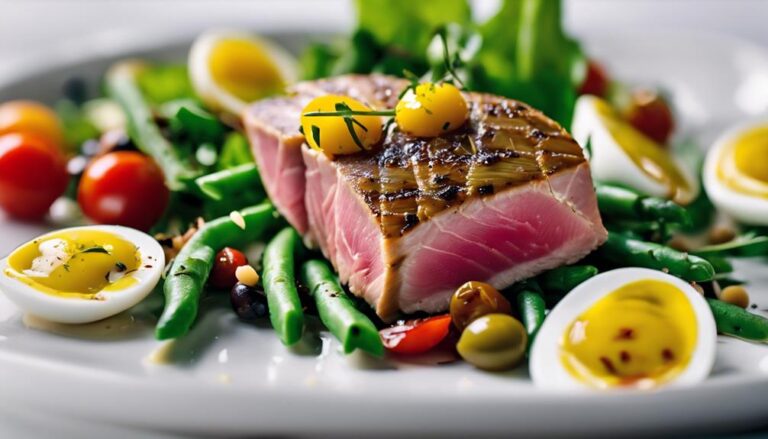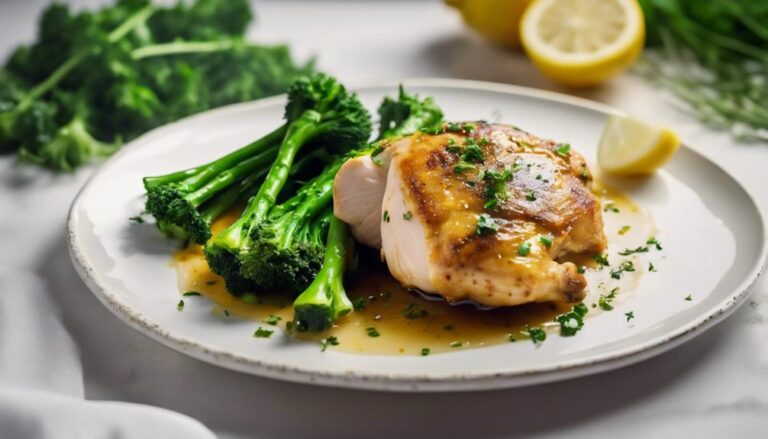Sous Vide Asparagus Soup With Crispy Prosciutto
Embark on a culinary journey with Sous Vide Asparagus Soup, where the asparagus flavors are intensified through precise cooking. The crispy prosciutto adds a textural contrast that elevates the taste experience. Dive into the sophistication of this dish, merging delicate flavors and textures for a truly exquisite sensation. Explore the nuances of sous vide cooking and the artful balance of ingredients. Uncover the secrets of blending techniques and prosciutto garnish, creating an unforgettable dish that is a feast for the senses. Discover the world of culinary refinement that awaits with Sous Vide Asparagus Soup with Crispy Prosciutto.
What You Will Learn Here
- Sous vide method preserves asparagus flavor and color.
- Crispy prosciutto provides a textural contrast.
- Precision cooking with sous vide for optimal results.
- Intense flavors with a delicate finish.
- Balancing asparagus soup richness with prosciutto's saltiness.
Asparagus Cultivation Origins

Asparagus has a rich history, tracing its cultivation origins back to ancient times. The evolution of asparagus growing techniques has played a significant role in shaping the modern methods used today.
Exploring the historical development of asparagus farming offers valuable insights into the agricultural practices that have sustained this prized vegetable over the centuries.
Historical Asparagus Origins
Originally cultivated in ancient times by civilizations across the Mediterranean region, the origins of this prized vegetable trace back to a rich history of cultivation practices and culinary significance. Asparagus, a symbol of springtime renewal and luxury, has been intertwined with culinary trends, evolving from a delicacy reserved for the elite to a versatile ingredient enjoyed by many. Its nutritional benefits and seasonal availability have made it a staple in various cuisines, celebrated for its unique flavor and tender texture. Below is a table highlighting some key aspects of historical asparagus origins:
| Aspect | Description | Significance |
|---|---|---|
| Cultivation Methods | Hand-harvested | Labor-intensive |
| Culinary Uses | Roasted, grilled, pickled | Diverse preparations |
| Historical Significance | Roman Empire delicacy | Royal associations |
Asparagus Growing Evolution
Having explored the historical origins and culinary significance of asparagus, the evolution of its cultivation techniques discloses a fascinating journey of agricultural innovation and adaptation. Asparagus breeding has been a pivotal aspect of its cultivation history, with ancient civilizations gradually refining the plant to enhance its taste, texture, and yield.
Over time, through meticulous crossbreeding and selection, asparagus varieties with desirable traits have emerged, showcasing the ingenuity and dedication of growers. The cultivation history of asparagus is rich with experimentation and perseverance, as farmers have continually endeavored to develop hardier, more productive crops.
This evolution in cultivation techniques not only reflects the deep-rooted connection between humans and asparagus but also highlights the ongoing quest for agricultural excellence in the domain of asparagus farming.
Asparagus Farming Techniques
Through centuries of agricultural innovation and experimentation, the cultivation techniques employed for asparagus have evolved to optimize yield, quality, and sustainability. Organic farming practices have gained popularity in asparagus cultivation, focusing on natural methods to enhance soil health and reduce environmental impact.
Sustainable agriculture principles are increasingly integrated into modern farming techniques, emphasizing long-term viability and minimal ecological harm. Asparagus farming now involves precision irrigation systems to conserve water, advanced crop rotation strategies to maintain soil fertility, and integrated pest management to minimize the use of chemicals.
Asparagus Varieties for the Soup

Which asparagus varieties are best suited for creating a rich and flavorful soup? When selecting asparagus for your soup, consider the different flavor profiles that each variety offers. Asparagus comes in various types, each with its own unique taste and texture, making your soup creation an exciting culinary adventure. Here are three excellent asparagus varieties to elevate your soup game:
- Green Asparagus: This classic variety is known for its slightly sweet and grassy flavor, making it a popular choice for soups. Green asparagus is widely available and can be found in markets almost year-round, with its peak season during the spring and early summer months.
- Purple Asparagus: With a more fruity and nutty flavor compared to its green counterpart, purple asparagus adds a delightful twist to your soup. This variety is best enjoyed during its peak season in late spring.
- White Asparagus: Known for its milder and more delicate taste, white asparagus offers a subtle flavor that pairs well with creamy soups. This variety is traditionally grown in darkness to prevent chlorophyll production, giving it a unique flavor profile. White asparagus is typically available in the spring months.
Tasty Asparagus Soup Variations
Explore the delightful array of asparagus soup variations such as the Sous Vide Asparagus Soup Recipe, the velvety Creamy Asparagus Bisque Recipe, and the savory Asparagus and Pancetta Risotto. Each variation offers a unique twist on the classic asparagus soup, from the precision of sous vide cooking to the richness of a creamy bisque.
Elevate your culinary experience by trying out these flavorful and inventive takes on traditional asparagus soup.
Sous Vide Asparagus Soup Recipe
For a delightful twist on traditional asparagus soup, consider experimenting with various tasty variations in your sous vide cooking adventures. Utilizing sous vide equipment opens up a world of possibilities for enhancing the flavors and textures of your asparagus soup.
When exploring flavor pairings, think about combining asparagus with ingredients like lemon, thyme, or Parmesan to elevate the taste profile of your soup. Here are three innovative variations to try:
- Smoky Bacon Infusion: Enhance the soup's richness by adding a sous vide-cooked bacon infusion, imparting a delicious smoky flavor.
- Coconut Curry Elixir: Create a unique fusion by infusing coconut milk with curry spices in the sous vide, adding an exotic twist to your asparagus soup.
- Truffle Essence Enhancement: Elevate the soup's elegance by infusing truffle oil into the sous vide-cooked asparagus, imparting a luxurious earthy flavor.
Creamy Asparagus Bisque Recipe
Elevate your culinary repertoire with a luxurious twist on traditional asparagus soup as we explore the delectable domain of Creamy Asparagus Bisque Recipe. This variation offers a velvety smooth texture that melts in your mouth, making each spoonful a moment of pure indulgence. The richness of the asparagus combined with a hint of cream creates a symphony of flavors that will leave your taste buds longing for more.
To perfect this dish, consider these key elements:
- Flavorful Seasonings: Infuse your bisque with aromatic herbs and spices to enhance the natural taste of the asparagus.
- Creamy Texture: Achieve the ideal consistency by blending the ingredients to a silky smooth finish.
- Garnish: Elevate your bisque with a drizzle of truffle oil or a sprinkle of parmesan for an added touch of sophistication.
Asparagus and Pancetta Risotto
With a harmonious blend of tender asparagus and savory pancetta, this risotto offers a tantalizing twist on traditional asparagus soup, adding depth and richness to this classic dish. Asparagus risotto opens up a world of flavor combinations that elevate the dining experience.
- Creamy Texture: The creaminess of the risotto combined with the crunch of pancetta creates a delightful textural contrast.
- Balanced Flavors: The earthy taste of asparagus pairs perfectly with the salty notes of pancetta, creating a well-rounded flavor profile.
- Aromatic Delight: The aroma of the pancetta as it cooks infuses the risotto with a mouthwatering fragrance that enhances the overall dining experience.
Asparagus Soup Cooking Techniques
To master the art of creating a velvety asparagus soup, you must understand the advantages of utilizing the sous vide method.
Pay close attention to blending techniques as they can greatly impact the texture and overall taste of your soup.
Additionally, consider innovative garnishes like crispy prosciutto to elevate the dish and add a delightful contrast of flavors.
Sous Vide Benefits
Utilizing the sous vide method in preparing asparagus soup can enhance the depth of flavors and maintain the vegetable's natural vibrant color and nutrients. Sous vide cooking involves sealing ingredients in a vacuum-sealed bag and cooking them in a precisely controlled water bath, ensuring even cooking at low temperatures. This gentle cooking method allows the asparagus to retain its natural tenderness and flavor, resulting in a velvety smooth soup with a concentrated taste. The sous vide equipment needed for this technique includes a water bath or immersion circulator and vacuum sealer. By utilizing sous vide, you can reveal the full potential of the asparagus, creating a soup that is both delicious and visually appealing.
| Sous Vide Benefits for Asparagus Soup | |
|---|---|
| 1. Enhanced flavor retention | 2. Maintained vibrant color |
| 3. Preserved nutrients |
Blending Tips
Enhancing the velvety texture of your asparagus soup requires mastering the art of blending – a crucial technique to achieve a harmonious fusion of flavors and a silky consistency.
When blending your soup, consider using a high-powered blender to guarantee a smooth and creamy result. Start by blending the soup in batches, allowing for proper aeration and avoiding overcrowding the blender.
To enhance the flavor profile, experiment with different blending techniques such as pulsing or blending on high speed for a shorter duration. Remember to season your soup appropriately and consider incorporating complementary flavor pairings like a hint of lemon zest or a touch of fresh herbs to elevate the taste.
Mastering these blending techniques will elevate your asparagus soup to a whole new level of culinary delight.
Prosciutto Garnish Ideas
Consider selecting thinly sliced prosciutto to add a delicate and savory touch to your asparagus soup, enhancing its overall flavor profile with a subtle richness.
When choosing a prosciutto pairing for your soup, opt for high-quality, thinly sliced prosciutto that crisps up beautifully when cooked. The prosciutto's crispy texture contrasts beautifully with the velvety smoothness of the soup, adding a delightful crunch to each spoonful.
To elevate the presentation, you can crumble the crispy prosciutto on top of the soup just before serving, creating an elegant garnish that not only looks visually appealing but also provides a burst of salty flavor.
Experiment with different prosciutto varieties to find the perfect match for your sous vide asparagus soup.
Final Thoughts
In reflection, the preparation of this Sous Vide Asparagus Soup provides a harmonious blend of flavors and textures that culminate in a delightful culinary experience. The advantages of this recipe lie in the innovative use of sous vide cooking, which guarantees that the asparagus retains its vibrant color and intense flavor. The method also allows for precise control over the cooking process, resulting in a velvety smooth soup without the risk of overcooking. The flavor profiles in this dish are nuanced, with the sweetness of the asparagus balanced by the savory notes of garlic and shallots, creating a multi-dimensional taste experience.
On the downside, some may find the sous vide technique time-consuming compared to traditional stovetop methods. Additionally, while the crispy prosciutto adds a textural contrast, it could be seen as an optional garnish for those looking to reduce sodium intake. Overall, this Sous Vide Asparagus Soup with Crispy Prosciutto is a sophisticated and flavorful dish that showcases the beauty of modern cooking techniques.
Frequently Asked Questions
Can I Use Frozen Asparagus Instead of Fresh for This Soup Recipe?
Yes, you can use frozen asparagus for the soup recipe. While fresh is ideal, frozen asparagus can be a convenient alternative. Consider vegetarian options for the garnish, such as grilled tofu. Properly stored, the soup can last for 3-4 days.
How Can I Make This Soup Vegetarian or Vegan-Friendly?
To make this soup vegetarian or vegan-friendly, enhance it with flavorful seasonings like smoked paprika and nutritional yeast. Utilize plant-based alternatives such as vegetable broth and coconut cream. Experiment with cooking techniques like roasting veggies for added depth.
Can I Substitute the Prosciutto With a Different Type of Meat or a Vegetarian Alternative?
Yes, you can substitute the prosciutto with meat alternatives like crispy tofu or tempeh bacon for a vegetarian option. Consider different garnishes such as smoked paprika or toasted nuts to enhance flavor profiles in your dish.
Are There Any Alternative Garnishes I Can Use to Replace the Crispy Prosciutto?
For a creative twist on garnishes, explore plant-based alternatives like roasted pepitas or coconut bacon. Elevate flavors with savory seasonings such as smoked paprika or truffle salt. These alternatives provide a unique and tasty touch to your dish.
How Long Can I Store Leftover Asparagus Soup in the Refrigerator?
When storing leftover asparagus soup in the refrigerator, remember it generally stays fresh for 3-4 days. To maintain quality, cool it quickly before placing in airtight containers. Consider freezing portions for longer shelf life. Enjoy this flavorful dish mindfully!
Conclusion
Indulge in the luxurious combination of velvety sous vide asparagus soup and crispy prosciutto.
The delicate flavors of the asparagus are elevated by the rich, savory notes of the prosciutto, creating a symphony of taste and texture in each spoonful.
This soup is a perfect example of how simple, high-quality ingredients can come together to create a truly exquisite dish that will impress even the most discerning of palates.
Bon appétit!









